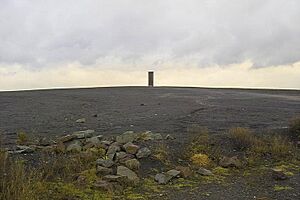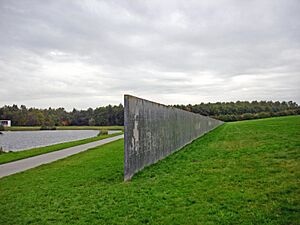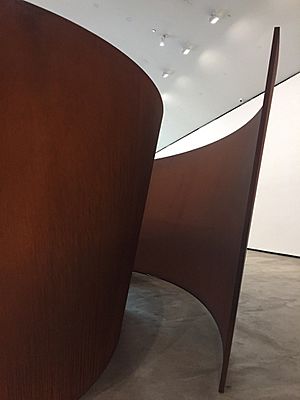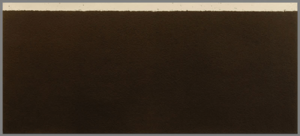Richard Serra facts for kids
Quick facts for kids
Richard Serra
|
|
|---|---|
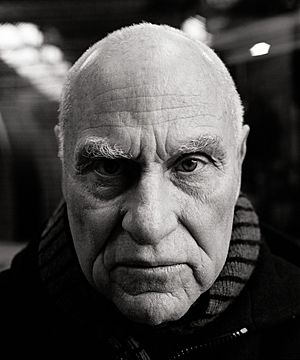
Richard Serra photographed by Oliver Mark, Siegen 2005
|
|
| Born | November 2, 1938 |
| Died | March 26, 2024 (aged 85) Orient, New York, U.S.
|
| Nationality | American |
| Education | University of California, Berkeley (attended) University of California, Santa Barbara (B.A. 1961) Yale University (B.F.A. 1962, M.F.A. 1964) |
| Movement | Postminimalism, Process Art |
| Spouse(s) | |
Richard Serra (born November 2, 1938 – died March 26, 2024) was an American artist. He was famous for his huge, abstract sculptures. These artworks were often made for specific places, like landscapes, cities, or buildings. His art style is mostly linked to Postminimalism, which is a type of art that came after Minimalism.
Many people called Serra "one of his era’s greatest sculptors." He focused on the materials he used and how people interacted with his art and the place it was in.
Serra first studied English literature at the University of California, Berkeley. Later, he switched to art. He earned his bachelor's degree in English Literature from the University of California, Santa Barbara in 1961. There, he met important artists like Rico Lebrun. To support himself, Serra worked in steel mills. This early experience with industrial materials greatly influenced his art.
He continued his studies at Yale University, getting a degree in Art History and a master's degree in 1964. In 1964, while in Paris on a Yale scholarship, he became friends with composer Philip Glass. He also explored the studio of famous sculptor Constantin Brâncuși. Both of these experiences had a big impact on his work. His time in Europe also led him to change from painting to sculpture.
From the mid-1960s, especially after moving to New York in 1966, Serra worked to change what sculpture could be. He started with experiments using materials like rubber, neon, and lead. Later, he created his large steel artworks. His early works in New York, like To Lift (1967) and Thirty-Five Feet of Lead Rolled Up (1968), showed his interest in industrial materials. They also explored the physical qualities of the materials he chose.
His large sculptures, placed in cities and natural areas, changed how people experienced art. Sometimes, they caused arguments, like his sculpture Tilted Arc in Manhattan in 1981. Serra was married to artist Nancy Graves from 1965 to 1970. He then married Clara Weyergraf in 1981, and they stayed together until his death in 2024.
Contents
Early Life and Learning
Richard Serra was born in San Francisco, California. He was the second of three sons to Tony and Gladys Serra. His father was from Mallorca, Spain, and his mother was from Odessa, Russia.
From a young age, his mother encouraged him to draw. Young Richard always carried a small notebook for his sketches. His mother would often introduce him as "Richard the artist." His father worked as a pipe fitter at a shipyard near San Francisco. Serra remembered visiting the shipyard when he was four years old to see a boat launch. He watched the ship change from a huge, heavy object to something that floated easily. He later said that "All the raw material that I needed is contained in the reserve of this memory."
Serra studied English literature at the University of California, Berkeley in 1957. He then moved to the University of California, Santa Barbara, where he finished his bachelor's degree in English Literature in 1961. In Santa Barbara, Serra met mural artists Rico Lebrun and Howard Warshaw. They were both in the Art Department and helped guide Serra. During this time, Serra worked in steel mills to earn money, as he did off and on from age 16 to 25.
Serra studied painting at Yale University. He earned both a bachelor's degree in Art History and a master's degree in 1964. Other artists who also went to Yale at that time included Chuck Close and Nancy Graves. At Yale, Serra met visiting artists from the New York School, such as Philip Guston and Robert Rauschenberg. In his last year at Yale, Serra taught a color theory class. After graduating, he helped check the famous color theory book "Interaction of Color" by Josef Albers.
In 1964, Serra received a one-year travel scholarship from Yale. He went to Paris, where he met the composer Philip Glass, who became a close friend and collaborator. In Paris, Serra spent time sketching in Constantin Brâncuși's studio. This studio was partly rebuilt inside the Musée National d'Art Moderne. This allowed Serra to study Brâncuși's work and later develop his own ideas about sculpture. An exact copy of Brâncuși's studio is now across from the Centre Pompidou.
Serra then spent the next year in Florence, Italy, on a Fulbright Grant. In 1966, while still in Italy, Serra visited the Prado Museum in Spain. He saw Diego Velázquez's painting, "Las Meninas." He realized he could not paint better than that and decided to stop painting and focus on sculpture.
While still in Europe, Serra started trying out new materials for sculpture. He had his first solo art show called "Animal Habitats" at Galleria Salita in Rome. This show featured artworks made with live and stuffed animals. These early works were seen as part of the Arte Povera art movement.
Artworks
Early Artworks
Serra returned from Europe and moved to New York City in 1966. He continued to create art using new materials like rubber, latex, fiberglass, neon, and lead. His "Belt Pieces" were made from strips of rubber hung on the wall, using gravity to shape them. In his sculpture Belts (1966–67), Serra combined neon with long strips of rubber. This work was similar to the repeating patterns in Jackson Pollock's Mural (1963).
Around that time, Serra wrote Verb List (1967). This was a list of action words like cast, roll, tear, and prop. He used these words as instructions for his sculptures. To Lift (1967), Thirty-Five Feet of Lead Rolled Up (1968), Splash Piece (1968), and Casting (1969) were some of his action-based works that came from this list. Serra used lead in many of his creations because it was easy to work with. Lead can be rolled, folded, ripped, and melted.
With To Lift (1967), Serra lifted a 10-foot (3 meter) sheet of rubber off the ground to make a standing shape. For Thirty-five Feet of Lead Rolled Up (1968), Serra, with help from Philip Glass, unrolled and then rolled a sheet of lead as tightly as they could.
In 1968, Serra's work was shown in a group exhibition called "Nine at Castelli" in New York. He displayed Prop (1968) and Scatter Piece (1968). He also created Splashing (1968) by throwing hot, melted lead against the corner where the floor and wall met. In 1969, his piece Casting was part of the exhibition Anti-Illusion: Procedures/Materials at the Whitney Museum of American Art in New York. For Casting, he again threw molten lead against the floor and wall corner. He then pulled the hardened lead casting away and repeated the action, making a series of standing shapes.
"To prop" was another action word from Serra's "Verb List." He used it for a series of artworks made of lead plates and poles. These pieces stayed upright by leaning on each other and using gravity. Serra's early "Prop Pieces," like Prop (1968), mostly used the wall for support. Serra wanted to move away from the wall because he felt it made the art too much like a picture. In 1969, he propped four lead plates on the floor like a house of cards. This sculpture, One Ton Prop: House of Cards (1969), weighed 1 ton. The four plates supported themselves.
Another important moment for Serra happened in 1969. Artist Jasper Johns asked him to make a "Splash Piece" in Johns's studio. While Serra was heating lead plates to splash against the wall, he took one of the larger plates and placed it in a corner, where it stood on its own. Serra's move into creating art that changed a space came soon after with the sculpture Strike: To Roberta and Rudy (1969–71). Serra wedged an 8 by 24-foot (2.4 by 7.3 meter) steel plate into a corner. This divided the room into two equal parts. The artwork invited people to walk around it, changing how they saw the room as they moved.
Serra first realized he could work on a very large scale with his Skullcracker Series. He made these during the "Art and Technology" exhibition at the L.A. County Museum of Art in 1969. He spent ten weeks building many temporary stacked steel pieces at the Kaiser Steelyard. Using a crane, he explored how counterbalance and gravity worked. The stacks were as tall as 30 to 40 feet (9 to 12 meters) and weighed between 60 and 70 tons. Steel workers knocked them down at the end of each day. The huge size of these stacks helped Serra start thinking about his art outside of gallery and museum spaces.
Art in Landscapes
In 1970, Serra received a Guggenheim Fellowship and traveled to Japan. His first outdoor sculptures, To Encircle Base Plate (Hexagram) (1970) and Sugi Tree (1970), were both placed in Ueno Park as part of the "Tokyo Biennale."
While in Japan, Serra spent most of his time studying the Zen gardens and temples of the Myoshin-ji in Kyoto. The way the gardens were laid out showed him that a landscape is a complete area that you can only experience by walking through it. The gardens changed how Serra saw space and time together. When he returned to the US, he built his first site-specific outdoor artwork: To Encircle Base Plate Hexagram, Right Angles Inverted (1970). For this, Serra put two half-circle steel pieces, forming a ring 26 feet (7.9 meters) wide, into the surface of 183rd Street in the Bronx. The artwork could be seen in two ways: either when someone walked directly onto it or from above, looking down from a stairway.
Throughout the 1970s, Serra continued to make outdoor sculptures for cities and natural areas. Serra was interested in the shape of the land and how people relate to it through movement, space, and time. His first landscape artwork was made in late 1970. Art supporters Joseph and Emily Rauh Pulitzer asked Serra to build a sculpture on their land near St. Louis, Missouri. Pulitzer Piece: Stepped Elevation (1970–71) was Serra's first large landscape artwork. Three steel plates, 5 feet (1.5 meters) high and 40 to 50 feet (12 to 15 meters) long, were placed across about 3 acres (12,140 square meters). The plates were placed based on how the land sloped. Each plate was pushed into the ground until its top edge was 5 feet (1.5 meters) high. Serra wanted the plates to act like cuts in the landscape, creating new horizons as people walked among them.
Shift (1970–72), Serra's second landscape project, was built in a field owned by collector Roger Davidson in King City, Ontario. The sculpture is made of six straight concrete sections placed along the sloping land. In 2013, Shift was named a Heritage Site under the Ontario Heritage Act. Like Pulitzer Piece, Shift was based on the height changes of the land over a certain distance. The top edges of the plates act like a horizon, placed at specific height levels as you walk across the entire field.
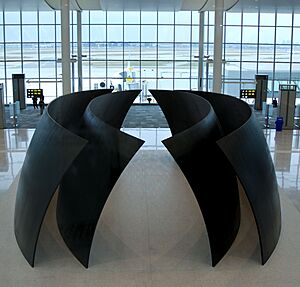
Serra's later site-specific works in landscapes continued to explore the shape of the land. They showed how the sculpture relates to this shape through movement, thought, and how the viewer sees it. Some of his most famous landscape works include Porten i Slugten (1983–86) at the Louisiana Museum of Modern Art in Denmark. Also, Afangar (Stations, Stops on the Road, To Stop and Look: Forward and Back, To Take It All In) (1990) on Videy Island, Iceland. Others are Schunnemunk Fork (1991) in Storm King Art Center, New York; Snake Eyes and Box Cars (1993) in Sonoma County, California; Te Tuhirangi Contour (2000–2) in Kaipara, New Zealand; and East-West/West-East (2014) in Qatar.
The sculpture Porten i Slugten (1983–86) was made for the Louisiana Museum of Modern Art in Humlebaek, Denmark. After walking the museum grounds, Serra chose a ravine that went towards the Kattegat Sea as the spot for his sculpture. This ravine was the only area on the grounds that had not been changed by landscaping. Two plates were set at an angle to each other at the end of a sloping path that led to the ravine. The plates act like a gate that opens as you walk down the path towards the sea. When seen from the middle of a bridge that crosses the ravine and leads to the museum, the two plates look like a single flat surface, as if the gate had closed. As you walk down from the museum to the ocean below, the plates seem to swing continuously.
In 1988, the National Gallery of Iceland asked Serra to build an artwork. Serra chose Videy Island for Afangar (Stations, Stops on the Road, To Stop and Look: Forward and Back, To Take It All In) (1990). This sculpture has nine pairs of basalt columns, which are stones found in Iceland. They are placed along the edge of Vesturey, in the western part of the island. All nine spots have the same height levels. The stones in each pair are at heights of 9 and 10 meters. The tops of all the stones are level. All stones at the higher height are 3 meters tall, and all stones at the lower height are 4 meters tall. Because the land's shape changes, the stones in a pair are sometimes closer together and sometimes farther apart. The up and down movement of Videy Island and the surrounding land is seen against the fixed height of the standing stones. The stones are visible along the island's horizon and help you understand the changing landscape around you.
Te Tuhirangi Contour (2000–2) is located on a large open field at Gibbs Farm in Kaipara, New Zealand. The sculpture is 20 feet (6 meters) high and stretches 844 feet (257 meters) as one continuous shape. It follows the rolling hills and the way the landscape expands and shrinks. The sculpture's height is perpendicular to the slope of the land.
East-West/West-East (2014) is located in the Brouq Nature Reserve in Qatar. It was asked for by Sheika al-Mayassa al-Thani of Qatar. It has four steel plates that are either 54.75 or 48.5 feet (16.7 or 14.8 meters) high. The plates are placed at different distances from each other in a valley between two gypsum plateaus. The plates are all level with each other and with the height of the nearby plateaus. The artwork stretches for less than a kilometer, and all plates can be seen from either end.
Art in Cities
In landscapes, Serra's sculptures draw your eye to the shape of the land as you walk. His city sculptures, however, make you focus on the sculpture itself. They are often easier for the public to reach than his landscape works. They invite you to walk inside, through, and around them. Because city buildings are often tall, sculptures like Sight Point (1972–75) at the Stedelijk Museum Amsterdam, Netherlands, and Terminal (1977) in Bochum, Germany, match the vertical lines of the buildings around them.
Other city artworks include T.W.U. (1980) at the Deichtorhallen, Hamburg, Germany; Fulcrum (1986–87), in Broadgate, London; Exchange (1996) outside the City of Luxembourg; or 7 (2011) on a pier in Doha, Qatar. These sculptures often reflect the tallness of the buildings around them. Outdoor sculptures like St. John's Rotary Arc (1980), which was temporarily outside the Holland Tunnel in New York City, and Tilted Arc (1981), which was installed and later removed from New York City's Federal Plaza, are curved shapes or arcs. They seem to open and close depending on which way you walk around them.
Sight Point (1972–75) was Serra's first tall city artwork. It continued the ideas of balance from his earlier work Prop. Sight Point stands outside the Stedelijk Museum in Amsterdam, Netherlands. It has three tall steel plates, 10 feet (3 meters) wide and 40 feet (12 meters) high. They lean in at an angle, forming a triangular space on the ground with three openings you can walk through. Once inside, you can look up and see the sky framed by the triangular shape made by the leaning plates.
Another tall sculpture, Terminal (1977), was created for "Documenta VI" in 1977. It was permanently placed on a traffic island in front of a train station in Bochum, Germany. Serra chose this spot because it was near a busy area. Exchange (1996) is located in a traffic circle on top of a highway tunnel. It is made of seven trapezoid-shaped plates. The sculpture is 60 feet (18 meters) high and can be seen by drivers as they enter and leave Luxembourg City.
In 1980, Serra installed two sculptures in New York City with help from the Public Art Fund. T.W.U. (1980) and St. John's Rotary Arc (1980) were both placed in areas where cars and people gathered. T.W.U, a tall sculpture with three vertical plates, each 36 feet (11 meters) high, was placed at a subway entrance near West Broadway. This sculpture is now permanently outside the Deichterhallen in Hamburg, Germany. St. John's Rotary Arc, one of Serra's first curved sculptures, was 12 feet (3.6 meters) high and stretched 180 feet (55 meters). From 1980 to 1988, this site-specific sculpture was at the traffic circle at the entrance and exit of the Holland Tunnel.
The next year, in 1981, a second curved sculpture called Tilted Arc (1981) was placed in New York City's Federal Plaza. The U.S. General Services Administration's Art-in-Architecture Program asked for this sculpture after a careful selection process. The sculpture's arc was 120 feet (36 meters) long and 12 feet (3.6 meters) high. It was a curve that tilted and leaned away from its base. It was anchored into the plaza at both ends, so the middle of the sculpture was raised. Serra wanted the sculpture to make people notice it as they crossed the plaza.
Tilted Arc was not liked by some workers in the Federal building. An eight-year effort to remove the sculpture followed, and Tilted Arc was finally taken down on March 15, 1989. Serra argued that "To remove Tilted Arc, therefore, is to destroy it." He believed that site-specific artworks should stay where they were made. After the hearing and the decision to remove it, Serra said he would not claim Tilted Arc as his work if it were moved. He would consider it a "copy." The case of Tilted Arc still shows the challenges that can arise with public art and its audience.
Gallery Artworks
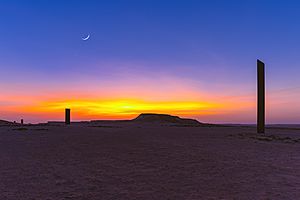
Serra had many exhibitions in art galleries and museums. His site-specific gallery installations were sometimes used to test new ideas. Serra's first solo exhibition in the US was at the Leo Castelli Warehouse in New York in 1969. There, he showed ten lead "Prop Pieces," a "Scatter Piece" called Cutting Device: Base Plate Measure (1969), and a "Splash Piece" called Splashing with Four Molds (To Eva Hesse) (1969).
After his process-based works of the late 1960s and early 1970s, Serra started to use only rolled or forged steel in his sculptures. Berlin Block (for Charlie Chaplin) (1977) was Serra's first forged sculpture. It was made for the plaza outside the Neue Nationalgalerie in Berlin and weighed 70 tons. Other forged sculptures include Elevation for Mies (1985–88) at Museum Haus Esters, Krefeld, Germany; Philibert et Marguerite (1985), in the Musee de Brou, France; Weight and Measure (1992), a temporary artwork at the Tate Gallery, London; Santa Fe Depot (2004), in the Museum of Contemporary Art San Diego; and Equal (2015) in the Museum of Modern Art, New York.
Serra's most famous series of sculptures using rolled steel plates are the Torqued Ellipses. In 1991, Serra visited Borromini's Church of San Carlo alle Quattro Fontane in Rome. He thought the oval shapes of the dome and floor were offset from each other. He decided to make a sculpture with this twisted shape. Serra built models in his studio by cutting two ellipse-shaped pieces of wood and putting a rod between them. He then turned the ellipses so they were at a right angle to each other and wrapped a sheet of lead around the shape. After making a pattern from the models, Serra worked with an engineer to build the actual sculptures.
In total, there are seven "Torqued Ellipses" and four "Double Torqued Ellipses" (an ellipse inside another ellipse) made between 1996 and 2004. Each sculpture has a different amount of twist and can be up to 13 feet (3.9 meters) high. All the sculptures have an opening so that people can walk through and around them. Three "Torqued Ellipses" are always on display at Dia Beacon, New York.
In 2005, "The Matter of Time," a special art installation, opened at the Guggenheim Museum in Bilbao, Spain. It included eight sculptures made over ten years, from 1994 to 2005. "The Matter of Time" showed how Serra's sculpture shapes changed over time. Serra chose to include five sculptures that came from his first twisted ellipse idea: one single, one double ellipse, and three twisted spirals. The "Torqued Spirals" came after the "Double Torqued Ellipses" when Serra decided to connect two double ellipses into one winding shape that you could enter and walk through.
The other sculptures in "The Matter of Time" are one closed (Blind Spot Reversed) and one open (Between the Torus and the Sphere) torus and spherical sculpture. There is also Snake: made of three parts, each with two identical cone-shaped sections turned opposite to each other, stretching 104 feet (31.7 meters) in total. Serra arranged the sculptures carefully. The way you move through the space makes you feel different sizes and proportions, and you become aware of time passing.
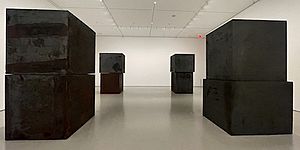
In 2008, Serra took part in Monumenta, an annual exhibition in Paris's Grand Palais that features one artist. For Monumenta, Serra installed a single sculpture, Promenade (2008). It had five plates, each 55 feet (16.8 meters) tall and 13 feet (4 meters) wide. They were placed 100 feet (30 meters) apart across the huge inside of the Grand Palais. In total, the sculpture stretched 656 feet (200 meters). The plates were not in a straight line but stood side by side, off the Grand Palais's center line. They tilted left or right, and leaned towards or away from each other and the viewer as people walked around them.
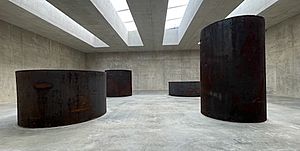
The sculpture Equal (2015), which is owned by The Museum of Modern Art in New York, has eight forged blocks. Each block is 5 by 5.5 by 6 feet (1.5 by 1.7 by 1.8 meters) and weighs 40 tons. The blocks are stacked in pairs and placed on their longer or shorter sides, so each stack is 11 feet (3.4 meters) tall. When you walk among the four stacks, you become aware of your own sense of weight, balance, and gravity compared to the sculptures.
Four Rounds: Equal Weight, Unequal Measure (2017) has four 82-ton (74 metric tons) forged cylinders of different sizes. It is permanently installed at Glenstone, Potomac, Maryland. The sculpture is inside a building designed by Thomas Phifer, who worked with Serra to show off the sculpture's huge size within the building.
Drawings
Drawing was a very important part of Serra's art. Serra made drawings on large sheets of canvas or special handmade paper. These drawings included horizontal or vertical designs, layers of overlapping sheets, or simple line drawings. He mainly used paintstick, lithographic crayon, or charcoal, and his drawings were always black. Serra tried different ways and tools to use and apply the materials. He often pushed the limits of drawing to create a physical experience of movement, time, and space. The artist said that his drawing practice involved "repetition, knowing there's no possibility of repeating, knowing that it's going to yield something different each time."
After he started making sculptures that changed space, like Strike: To Roberta and Rudy (1969–71), Serra also became interested in changing architectural space with drawings. In 1974, Serra began his "Installation Drawings." These were large, site-specific sheets of canvas completely covered in paintstick and stapled to the wall. The "Installation Drawings" covered the wall, or walls, of a given space. Shafrazi and Zadikians were two of Serra's first "Installation Drawings." Both were shown at Leo Castelli Gallery, New York, in 1974. They were about 10.5 feet (3.2 meters) high and 18 feet (5.5 meters) wide in total. Serra continued to make "Installation Drawings" throughout his career.
Other notable drawing series include: "Diptychs" (1989), "Dead Weight" (1991–92), Weight and Measure (1993–94), Videy Afangar (1989–91), Rounds (1996–97), out-of-rounds (1999–2000), Line Drawings (2000–02), Solids (2008), Greenpoint Rounds (2009), Elevational Weights (2010), Rifts (2011–18), Transparencies (2011–13), Horizontal Reversals (2014), Rambles (2015–16), Composites (2016), Horizontals and Verticals (2016–17), and Orchard Street (2018).
Large exhibitions of Serra's drawings have been held in many countries. These include Richard Serra: Tekeningen/Drawings 1971–1977 at the Stedelijk Museum, Amsterdam, in 1978. Also, Richard Serra: Tekeningen/Drawings at the Bonnefantenmuseum, Maastricht, in 1990. A major show called Richard Serra Drawings: A Retrospective was at The Metropolitan Museum of Art, New York, the San Francisco Museum of Modern Art, and Menil Collection, Houston, from 2011 to 2012. Another show, Richard Serra: Drawings 2015–2017: Rambles, Composites, Rotterdam Verticals, Rotterdam Horizontals, Rifts, was at the Museum Boijmans van Beuningen, Rotterdam, Netherlands, in 2017.
Prints
Serra started making prints in 1972. Working closely with Gemini G.E.L. in Los Angeles, Serra created new and unusual printing methods. He made over 200 printed artworks. Like his sculptures and drawings, his prints show his interest in the art-making process, size, and trying out different materials.
His early lithographs, starting in 1972, included prints like Circuit, Balance, Eight by Eight, or 183rd & Webster Avenue. Each was named after a sculpture he made around the same time. In 1981, Serra created his first series of lithographs, with seven different prints, titled Sketch #1 through Sketch #7. That same year, Serra began to make larger prints such as Malcolm X, Goslar, or The Moral Majority Sucks.
After pushing lithography as far as he could, Serra began to work with silkscreen to create a unique texture in his prints. He would first put a layer of ink onto the paper. Then, he would apply a layer of paint stick through a second screen, making a rich and textured surface.
Serra continued to use his silkscreen method, sometimes combining it with etching and aquatint. Print series include: Videy Afanger (1991); Hreppholer (1991); WM (1996); Rounds (1999); Venice Notebook (2001); Between the Torus and the Sphere (2006); Paths and Edges (2007); Level (2008); Junction (2010); Reversal (2015); Elevational Weight (2016); Equal (2018); and (2019).
Films and Videos
From 1968 to 1979, Serra made a collection of films and videos. Even though he started working with sculpture and film at the same time, Serra understood that each had different abilities. He did not try to solve sculpture problems in his films and videos. Serra worked with several artists, including Joan Jonas, Nancy Holt, and Robert Fiore, on his films and videos. His first films, Hand Catching Lead (1968), Hands Scraping (1968), and Hand Tied (1968), showed a series of actions: a hand trying to catch falling lead; pairs of hands moving lead shavings; and tied hands untying themselves.
A later film, Railroad Turnbridge (1976), shows the landscape around the Willamette River in Portland, Oregon, as a bridge turns. Steelmill/Stahwerk (1979), made with art historian Clara Weyergraf, has two parts. The first part includes interviews with German steel-factory workers about their jobs. The second part shows the making of Serra's sculpture Berlin Block (for Charlie Chaplin).
Shows and screenings of his films were held at the Kunstmuseum Basel, Switzerland, in 2017. Also, at Anthology Film Archives, New York, from October 17–23, 2019. And at Harvard Film Archive, from January 27 – February 9, 2020. In 2019, Serra gave all his film and video works to The Museum of Modern Art in New York.
Art Shows
Serra's first solo art show was in 1966 at Galleria Salita in Rome, Italy. His first solo show in the US was at the Leo Castelli Warehouse, New York, in 1969. His first solo museum exhibition was at the Pasadena Art Museum in California in 1970.
The first big show looking back at all his work was at the Museum of Modern Art, New York, in 1986. A second big show was held at The Museum of Modern Art, New York, in 2007.
The first overview of his drawings was at the Stedelijk Museum Amsterdam in 1977 and then traveled to the Kunsthalle Tübingen in 1978. A second large drawing show was presented at The Metropolitan Museum of Art, New York; the San Francisco Museum of Modern Art; and The Menil Collection, Houston, from 2011 to 2012. A look at the artist's films and videos was shown at the Kunstmuseum Basel in 2017.
Serra had solo exhibitions at many other museums. These include the Staatliche Kunsthalle Baden-Baden (1978), Museum Boijmans Van Beuningen, Rotterdam (1980), Musée National d'Art Moderne, Centre Pompidou, Paris (1983–1984), and the Museum of Contemporary Art, Los Angeles (1998–1999).
Art Collections
Serra's art is part of many museums and public collections around the world. Some selected museum collections include The Museum of Modern Art, New York; The Whitney Museum of American Art, New York; Art Gallery of Ontario, Toronto; Art Institute of Chicago; Bonnefantenmuseum, Maastricht, The Netherlands; Centre Georges Pompidou, Musée National d’Art Moderne, Paris; Modern Art Museum of Fort Worth, Texas; Dia Art Foundation, New York; Guggenheim Museum Bilbao and New York; Hamburger Kunsthalle, Hamburg, Germany; Hirshhorn Museum and Sculpture Garden, Smithsonian Institution, Washington, DC; Moderna Museet, Stockholm; and Glenstone Museum, Potomac, Maryland.
Some selected public collections include the City of Bochum, Germany; City of Chicago, Public Art Collection; City of Goslar, Germany; City of Hamburg, Germany; City of St. Louis, Missouri; City of Tokyo, Japan; City of Berlin, Germany; City of Paris, France; and Collection City of Reykjavík, Iceland.
Personal Life
Richard Serra moved to New York City in 1966. In 1970, he bought a house in Cape Breton, Nova Scotia, and spent his summers working there. Serra married art historian Clara Weyergraf in 1981. As of 2019, Serra had a home in Manhattan and studios in Nova Scotia and the North Fork of Long Island.
Serra passed away from pneumonia at his home in Orient, New York, on March 26, 2024. He was 85 years old.
Awards and Honors
Serra received many important awards and honors. These include the Fulbright Grant (1965–66) and the Guggenheim Fellowship (1970). He was also recognized by France with the Chevalier de l’Ordre des Arts et des Lettres in 1985 and 1991. In 1994, he received the Praemium Imperiale from the Japan Arts Association in Tokyo.
He earned a Leone d’Oro for his lifetime achievements at the Venice Biennale, Italy, in 2001. He also became a member of the American Academy of Arts and Letters in 2001. Other honors include the Orden pour le Mérite für Wissenschaften und Künste from Germany (2002) and the Orden de las Artes y las Letras de España from Spain (2008).
In 2014, he received The National Arts Award: Lifetime Achievement Award from Americans for the Arts. That same year, he got the Hermitage Museum Foundation's Award for Lifetime Contributions to the World of Art. In 2015, France honored him again with the Chevalier de l’Ordre national de la Légion d’honneur. He also received the Landesmuseum Wiesbaden Alexej-von-Jawlensky-Preis in 2017 and a J. Paul Getty Medal in 2018.
Writings and Interviews
You can find a full collection of writings by Richard Serra and interviews with him in these three books:
- Richard Serra: Writings, Interviews. Chicago and London: The University of Chicago Press, 1994. This book includes writings by the artist and interviews by many people, including Philip Glass and Clara Weyergraf.
- Richard Serra: Interviews, Etc. 1970–1980. Yonkers, New York: The Hudson River Museum, 1980. This was written and put together by Richard Serra with Clara Weyergraf.
- Richard Serra: Schriften, Interviews 1970–1989. Bern: Benteli Verlag, 1990. This is a German translation of the 1980 book, with more contributions from other artists and writers.
Images for kids
-
Sea Level (South-west part), Zeewolde, Netherlands
-
Hours of the Day (1990), Bonnefanten Museum, Maastricht
-
Richard Serra's Tilted Spheres in Toronto Pearson International Airport (Terminal 1, Pier F)
-
East-West/West-East (2014) by Richard Serra in Zekreet Qatar
-
Equal (2015) at the Museum of Modern Art in 2022
-
Four Rounds: Equal Weight, Unequal Measure (2017) at Glenstone in 2022
See Also
 In Spanish: Richard Serra para niños
In Spanish: Richard Serra para niños


